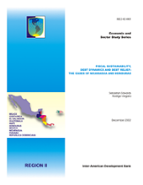Fiscal Sustainability, Debt Dynamics and Debt Relief: The Cases of Nicaragua and Honduras
Date
Dec 2002
The purpose of this paper is to analyze the relationship between fiscal policy, aggregate public sector debt sustainability, and debt relief. In particular, we develop a methodology to compute the fiscal policy path that is compatible with aggregate debt sustainability in the post-HIPC era (Highly Indebted Poor Countries relief initiative). This model explicitly considers the role of domestic debt, and quantifies the extent to which future debt sustainability depends on the availability of concessional loans at subsidized interest rates. The working of the model is illustrated for the cases of Honduras and Nicaragua. Both countries differ markedly in terms of the burdens of their external and internal debts. The results from our simulation analysis indicate that unless Nicaragua receives substantial concessional aid in the future, its public sector debt is likely to become unsustainable. In the case of Honduras, our simulation exercise shows that under reasonable parameters the country's fiscal stance as of 2001 is sustainable.



